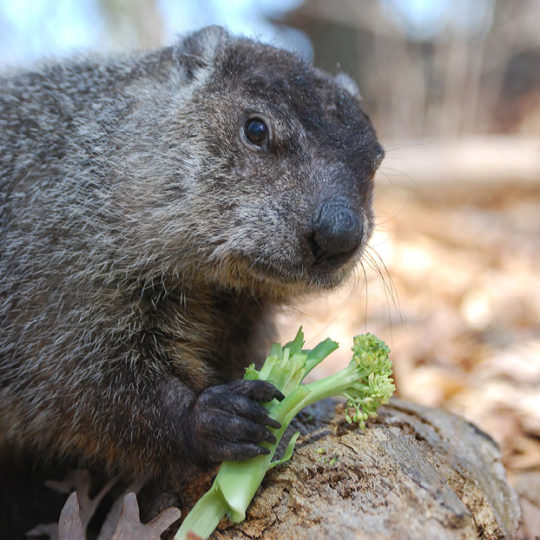Groundhog
Category:
MammalsAbout


Chesapeake Chuck is the Virginia Living Museum resident groundhog.
Watch for him every February 2nd when he predicts Hampton Roads weather with WAVY-TV Meteorologist, Jeremy Wheeler.
The ability of the famous Punxsutawney Phil to accurately forecast weather may be questionable, but early February is a good time to find out more about this interesting animal that sleeps through most of the winter.
A groundhog is a member of the rodent family, related to mice, muskrats, beavers, and squirrels. An adult measures about 18 inches from nose to tail tip and has a chubby body, furry tail, and short powerful legs. Groundhogs live at the edges of wooded areas, meadows or open brushy hillsides.
An adult groundhog lives alone except during the early spring mating season. The female gives birth to 4 or 5 blind, furless, four-inch long babies that depend completely on their mother for food, warmth and protection. After 6 weeks, the youngsters leave the protection of their burrow and begin to explore. By mid-summer, the young groundhogs set out on their own.
This expert digger uses strong clawed feet to move hundreds of pounds of earth and stones to create its burrow. The mound piled up at the main entrance, sometimes a foot across, is a great spot to look around for signs of danger, or just relax in the sun. When a groundhog, or whistle pig, senses danger, it gives a loud warning whistle then dives to safety. A burrow isn’t just a simple hole in the ground! It’s a complex underground network of tunnels and rooms that usually includes a main tunnel, at least one nest chamber, dead-end tunnels and up to five side entrances.
Throughout the spring and summer, a groundhog spends only 3 or 4 hours a day outside its burrow. Much of that time is spent eating. A groundhog doesn’t store extra food underground. It’s a true hibernator. During its long, deep sleep, all of its energy must come from stored body fat. A groundhog will fatten up to about 12 pounds before it hibernates in late fall. When it finally climbs out of its warm burrow in early spring, it may have lost 1/3 to 1/2 of its body weight!
Although groundhogs are preyed upon by dogs, foxes, raccoons, hawks, owls and occasionally weasels, the most serious threats to its survival are hunting, trapping and loss of habitat.





